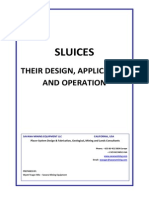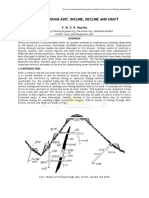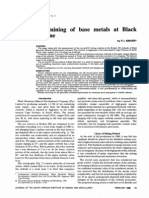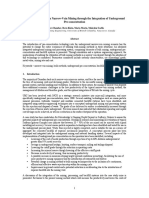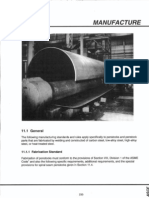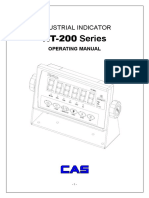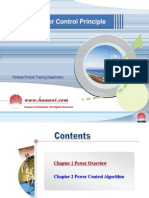Ore Pass Practice in Canadian Mines: by J. Hadjigeorgiou, J.F. Lessard, and F. Mercier-Langevin
Ore Pass Practice in Canadian Mines: by J. Hadjigeorgiou, J.F. Lessard, and F. Mercier-Langevin
Uploaded by
Jesus SalamancaCopyright:
Available Formats
Ore Pass Practice in Canadian Mines: by J. Hadjigeorgiou, J.F. Lessard, and F. Mercier-Langevin
Ore Pass Practice in Canadian Mines: by J. Hadjigeorgiou, J.F. Lessard, and F. Mercier-Langevin
Uploaded by
Jesus SalamancaOriginal Title
Copyright
Available Formats
Share this document
Did you find this document useful?
Is this content inappropriate?
Copyright:
Available Formats
Ore Pass Practice in Canadian Mines: by J. Hadjigeorgiou, J.F. Lessard, and F. Mercier-Langevin
Ore Pass Practice in Canadian Mines: by J. Hadjigeorgiou, J.F. Lessard, and F. Mercier-Langevin
Uploaded by
Jesus SalamancaCopyright:
Available Formats
Ore pass practice in Canadian mines
by J. Hadjigeorgiou*, J.F. Lessard*, and F. Mercier-Langevin*
Synopsis
This paper reviews ore pass practice in some Canadian mines in
Quebec and Ontario. In particular it reviews ore pass configuration,
flow control mechanisms and monitoring practice. A review of the
type of problems encountered and the tools to restore flow is also
presented.
Ore pass practice in some Canadian
mines
Ore pass systems are an integral part of the
materials handling system in the majority of
Canadian underground mines. This paper
presents some observations from a series of
in-depth studies in Canadian Mines. The main
source of information is a comprehensive
study by Hadjigeorgiou and Lessard (2004) in
Quebec mines, with further data derived by
ongoing investigations in Ontario operations
in the Sudbury basin. Extracted ore and
tonnage of Quebec operations are summarized
in Table I.
Ontario mines included in this investigation are massive deposits of nickel and
copper. Daily extraction tonnage ranged from 3
500 to 10 000 tons.
At every participating site, underground
assessments were complemented by data
collection, and site interviews with key mine
personnel from engineering, production, safety
and training departments. Collected mine data
included design, engineering, problems
encountered, and the successes and failures of
interventions. During site visits, the best
practices for safely removing hang-ups were
also recorded.
drop raising). In Quebec mines, Alimak raising
was used in 63% of driven ore passes while
only 3% were raise bored. Conventional and
drop raises represent 29% and 5% of the
sections, respectively. The dominance of
Alimak driven passes over raise bored passes
in Quebec mines is attributable to several
causes. It ensures a reasonable degree of
safety for the miners, while still allowing the
installation of support. Furthermore, the ability
to drive the Alimak pass from a single access
(as opposed to raise boring, which requires
that both the bottom and top accesses be
developed) and a strong expertise of local
mining contractors are also contributing
factors.
In the surveyed Ontario mines, raise
boring was used for 30% of excavated ore pass
sections, while Alimak was used in 39%. The
rationale for the use of raise boring was to
limit ground disturbance during excavation. A
chronological review of ore passes, however,
indicated that Ontario mines are moving away
from raise boring and using Alimak more
widely. In fact close to 70% of recently
excavated ore pass sections were driven by
Alimak, while only 15% were driven by raise
borer. The recent predominance of Alimak
raises is attributed to their facility to integrate
the installation of ground support during the
excavation cycle.
Ore pass section length
There is an inherent relationship between the
type of excavation method and section length.
Typically, sections excavated by drop raising
or conventional raising are shorter than
sections driven by Alimak or raise bored,
Table II. Atlas Copco (1997) reported the same
general trend in other raise applications.
Ore pass configuration
Ore passes are developed using either
mechanical (raise borer) or drill and blast
techniques (Alimak, conventional raising and
The Journal of The South African Institute of Mining and Metallurgy
VOLUME 105
* Laval University, Quebec City, Canada.
The South African Institute of Mining and
Metallurgy, 2005. SA ISSN 0038223X/3.00 +
0.00. This paper was first published at the SAIMM
Colloquium, Design, Development and Operation of
Rockpasses, 1617 November 2004..
REFEREED PAPER
DECEMBER 2005
809
Excavation method
T
r
a
n
s
a
c
t
i
o
n
P
a
p
e
r
Ore pass practice in Canadian mines
Table I
Quebec mines participating in the survey
Mine
Laronde
Louvicourt
Bousquet II
Bouchard-Hbert
Gonzague-Langlois
Doyon
Mouska
Kiena
Bell-Allard
Niobec
Type of orebody
Extracted ore
tpd*
Massive
Massive
Massive
Massive
Massive
Narrow-vein
Narrow-vein
Massive
Massive
Massive
Au, Zn, Cu
Cu, Zn, Au, Ag
Au, Cu
Zn, Cu, Au, Ag
Zn, Cu, Au, Ag
Au
Au, Ag
Au, Ag
Zn, Cu
Nb
5000
4300
1700
3000
3000
3500
450
2000
2200
3300
*tons per day
Table II
Excavation methods and recorded sections length
for Quebec mines
Excavation
method
Alimak raising
Conventional raising
Drop raising
Raise boring
Avgerage
length
(m)
Standard
deviation
(m)
106
48
47
132
51
20
22
62
Maximum Minimum
length
length
(m)
(m)
273
99
90
215
30
10
27
64
The length of ore pass sections in Quebec mines varies
widely (from 10 m to 273 m). Most excavated sections were
of a length between 30 to 100 m with a mean value of 87 m,
Figure 1. Ontario mines report longer sections averaging 108
m with a standard deviation of 60 m. In general it would
appear that the average section length in Canadian mines is
higher than the 46 m reported by Beus et al. (2001) for the
United States.
There are several practical and financial considerations
that influence the selection of an ore pass length. If, for
example, an operation aims to minimize its capitalized
development, it will end up driving short ore pass sections,
going from one level or sub-level to the next, concurrently as
the various levels are entering into production. Quite often a
mine that experienced problems when driving and operating
long sections will subsequently opt for shorter sections when
constructing new ore and waste passes. An excavation of
greater length is more likely to intersect zones of poor
ground. It also has a higher potential for problems and is
harder to bypass. Longer sections may also result in higher
material flow velocity in passes operated as flow-through.
and compaction. It should be noted that all vertical sections
are shorter than 100 m.
Ontario mines favor steep ore passes (80 8.3) in an
effort to ensure continuous material flow and limit hang-up
occurrences. A statistical analysis, however, can obscure site
specific practice. In one particular mine, operating in depth
and using multiple ore passes, the average inclination was
greater than 87.
Ore pass section shape
The majority of excavated ore passes are square or
rectangular. Circular sections are usually associated with
raise boring methods but in some instances, circular sections
were excavated using Alimak. In most cases, the main factor
dictating the choice between a rectangular and a square
section is local mine experience. Circular shape was used
based on anticipated higher stress regimes. It is of interest to
note that a review of ore pass surveys reveals that under
high stress, and with material flowing in an ore pass, a
design circular shape is not maintained for long (in unlined
ore passes).
Ore pass cross-sectional dimensions
Design dimensions for Quebec operations are given in
Figure 3. In the case where the cross-section varies along the
length of an ore pass section the smaller dimension, being
the most critical, is recorded. In the case of rectangular crosssections, again the smallest dimension is used. This results
in an average dimension of 2.1 m for Quebec mines. Ontario
mines have a relatively larger cross-sectional dimension of
2.5 0.6 m. Ore pass size is an important factor influencing
material flow. This is reflected in empirical guidelines linking
the potential for hang-ups with ore pass size and material
size.
Figure 1Length of excavated sections for Quebec mines (153)
Ore pass section inclination
Ore pass inclination in Quebec operations varies between 45
and 90, with an average inclination of 70, Figure 2.
Interviewed mine personnel provided contradictory justification for the choice of inclination and its desired effect on
material flow. The choice for a particular inclination is
dictated by the need to facilitate material flow, while at the
same time slow it down. Shallow sections may restrict flow,
especially if a high proportion of fine material is present,
while steeper excavations result in higher material velocities
810
DECEMBER 2005
VOLUME 105
REFEREED PAPER
Figure 2Inclination of excavated sections for Quebec mines (153)
The Journal of The South African Institute of Mining and Metallurgy
Ore pass practice in Canadian mines
Flow control infrastructure
Material flow control infrastructures used in Canadian mines
can be classified into 5 categories:
Finger raises
Finger raises are used to funnel material into a pass
intersecting two or more production levels. Typically, a finger
raise is a square opening with a smaller cross-sectional area
than the rockpass it feeds. The most common dimensions for
a finger raise are 1.5 and 1.8 m. The majority of ore passes
do not employ fingers or rely on a single finger. It is quite
unusual to have more than 3 fingers leading into a section.
A review of available cavity monitoring surveys, complemented by on site interviews, suggests that fingers often
result in localized impact zones to the detriment of the wall
integrity of ore passes. This is usually aggravated if fingers
are excavated using longhole blasting that often damages the
surrounding rock mass.
Screening of oversize material
Oversize material dumped into the passes may lead to
blockages or interlocking hang-ups. This can be avoided by
either instructing the mucking crew or by installing the
necessary infrastructure to restrict the entrance of the
oversize material. Canadian mines use some control of
infrastructure for approximately 55% of reported ore pass
systems. Typical types of infrastructure are illustrated in
Figure 4.
High maintenance costs are often associated with
scalpers, since big blocks tend to wedge between the bars.
Mucking crews can be persuasive in trying to push the
block through the bars with the bucket. This practice
damages both the bars and the scoop. Broken and missing
bars are often the result of this practice. The ability of a
scalper to retain big blocks is therefore greatly diminished. In
addition, the intrusion of a bar in the ore pass can lead to
severe obstruction further down the system. Another problem
associated with the use of scalpers is that big slabs of rock
can pass through. Of the three types of boulder retaining
infrastructure, grizzlies are the best to keep big blocks out of
the passes. Grizzlies require less maintenance than scalpers.
The grid dimensions with respect to muck size or bucket size
are critical. If the opening is too small, a lot of plugging at the
grizzlies will arise, hindering the mucking. Mantles are
relatively easier to construct and, given that they allow for
larger rock fragments (in excess of 90 cm), they have no
additional requirements for rock breakers. This is an
advantage for infrastructure costs, but the flow of large rocks
in an ore pass can contribute to wall degradation.
The Journal of The South African Institute of Mining and Metallurgy
Chutes with control chains are the most popular flow
control infrastructure in Quebec mines, Figure 5.
a) Scalper
b) Grizzly
c) Mantle
Figure 4Typical screening infrastructure
VOLUME 105
REFEREED PAPER
DECEMBER 2005
811
Figure 3Minimum diameter of excavated sections for Quebec
mines (153)
Control chains are heavy weighed chains suspended
from a headblock. They rely on their weight to slow
down or regulate the flow of ore from an ore pass. In
some instances where an additional level of control
over the flow of ore is needed, a hydraulic cylinder can
be added.
Chutes with crash gates are formed by a steel-lined
slide to which is attached a steel door (hinged at the
top) that physically stops the movement of ore when it
is pushed by hydraulic cylinders .The design is simple
and efficient, but there are known issues, such as the
steel door being kept from closing completely by a big
rock
Chutes with control chains operate on the same
principle as crash gates, with the difference that the
steel door is replaced by the set of chains. This
arrangement solves most of the problems associated
with large blocks wedged in the steel door
Chutes with control chains and gate are a variation on
the principle of the chute with control chains in that the
material flow is slowed by control chains but it is also
further hindered by the gradual lifting of the chute lip
or an arc gate. This lifting of the lip effectively reduces
the angle of the entire chute arrangement to the point
where this angle is less than the natural angle of
repose of the material
Feeders are chutes inclined at an angle higher than the
angle of repose of the material. Material flow is
restrained by a set of heavy circular chains. When flow
has to be restored, the chains are rotated, letting the
material slide beneath them.
T
r
a
n
s
a
c
t
i
o
n
P
a
p
e
r
Ore pass practice in Canadian mines
Ore pass monitoring
Figure 5Sections draw control infrastructures for Quebec mines
(153 sections)
Table III
Performance of ore passes in Quebec mines
Q Rating
Non-supported
# Sections
% Failed
> 5 (fair)
< 5 (poor)
Total
4
3
7
Ore pass management necessitates the use of reliable
monitoring techniques. Those systems can be either direct or
indirect and range from very simple (visual inspections) to
fully automated systems (laser). Several mines try to keep an
ore pass full as this practice mitigates the results of impact
loads on the side walls, and provides a degree of
confinement that contributes to the stability of the ore pass.
Keeping an ore pass full, or to a certain predefined level,
requires strict procedures. Several techniques are available to
monitor the level of muck in an ore pass, Table IV.
The available techniques to monitor the integrity of an
ore pass are listed in Table V. These are not used on a regular
basis but they are often used in response to reported
problems of frequent ore pass hang-ups.
The performance of liners in ore passes also has to be
monitored on a regular basis. The fact that liners are used in
response or in anticipation of problems should justify the use
of the monitoring techniques listed in Table VI.
0
100
43
Table IV
Q Rating
Reinforced
# Sections
% Failed
43
50
93
0
60
32
> 5 (fair)
< 5 (poor)
Total
Muck level monitoring systems in Canadian ore
passes
Type
System
Comments
Direct
Visual
Evaluation of the muck level is performed
periodically by supervising personnel.
Inaccurate. Cannot be automated
A weighted tape is used by supervising
personnel to periodically record the muck level.
Cannot be automated.
Laser systems can provide real time
muck level readings.
Very accurate. Can be automated.
High capital cost. Sensitive to dust.
Measuring
Tape
Reinforcement
Hadjigeorgiou et al. (2004) addressed the issues associated
with reinforcement and support. In Quebec mines the
majority of vertical or inclined excavations are constructed
using Alimak, thus facilitating the installation of
reinforcement and support.
Resin-grouted rebar constitutes the most popular
reinforcement type for ore pass systems. Nevertheless, the
most recently developed excavations are reinforced by resin
grouted short cable bolts. More recently several Canadian
Mines have used resin grouted short cable bolts, for example
the Strand-Lok Cable bolt system, as they have been found to
dissipate impact shock more efficiently than rigid support
systems.
Liners
The relationship between rock mass and ore pass operational
failure was addressed for 10 Quebec mines, Hadjigeorgiou
and Lessard (2003). Cavity monitoring surveys, volume
reconciliation from actual tonnage capacity and/or comments
from mine operators were used to quantify the expansion of
an ore pass. An ore pass section is considered to have failed
if it had expanded to twice its initial volume as recorded in
the original layout. The Q system, Barton et al. (1974) was
used to quantify rock mass quality. The results are
summarized in Table III.
Referring to Table III, there is no incidence of
uncontrolled ore pass failure in any rockpass section that had
a Q value greater than 5. It is suggested that liners should be
considered for ground conditions where Q is less than 5.
812
DECEMBER 2005
VOLUME 105
REFEREED PAPER
Laser
Indirect
Tonnage
Reconciliation
Subtracting pass capacity and pass
output to pass input (scoop buckets).
Highly inaccurate
Table V
Wall degradation monitoring systems in Canadian
ore passes
Type
System
Comments
Direct
Visual
Evaluation of wall degradation from the
upper access.
Inaccurate. Pass must be emptied
Drilling into the pass from nearby drifts to
determine an approximate profile.
Pass can be kept full.
Provides only localized data.
Necessitates access.
A camera is lowered into the pass
Necessitates the use of a buggy.
Pass must be emptied.
A cavity monitoring system provides a
full 3D profile of the pass
Accurate (occasional blind spots).
High capital cost. Necessitates access.
Pass must be emptied.
Drilling
Camera
CMS
Indirect
Tonnage
reconciliation
Subtracting pass output to
pass input (scoop buckets).
Pass can be kept full.
Highly inaccurate
The Journal of The South African Institute of Mining and Metallurgy
Ore pass practice in Canadian mines
Type
System
Comments
Direct
Visual
Visual evaluation of liner wear is
performed from the upper access
Inaccurate. Requires access.
Pass must be emptied.
A system of nails of different lengths
is added to the liner during installation.
As the liner wears, nails are exposed.
Provides only localized data.
Pass must be emptied for reading
unless the nails are instrumented
Wear
nails
Indirect
Mill
performance
Liner materials such as silica and
calcium aluminate can be detrimental
to metals recuperation at the mill. Poor
recuperation can be caused by
liner material failing.
Pass can be kept full.
Difficult to track in a multi-pass system
Ore pass problems
Analysing the causes of degradation is a complex process
due to the potential interaction of several mechanisms.
Table VII demonstrates the level of degradation observed in
the mines. An interesting observation was that seven of the
eight ore pass sections that reported a tenfold enlargement
from the design volume were used to transfer ore of unit
weight greater than 30 kN/m3. Only 4 of the 31 sections
showing an enlargement of two to four times the initial
volume came from mines handling ore with a unit weight of
27 kN/m3. Only two waste pass sections have exhibited an
enlargement of two times the initial volume and those
examples were located in high stress environments. It is quite
possible that there is a relationship between the material unit
weight and the degree of observed degradation.
Figure 6 summarizes the perceived degradation
mechanisms observed in ore and waste passes in Quebec
mines. These have been identified based on information
collected at each site. It is noted that quite often there is more
than one mechanism at work.
Morrison and Kazakidis (1995) have used data from the
Sudbury mining camp to provide a qualitative assessment of
the dominant degradation mechanisms. These include:
structural failures facilitated by material flow; scaling of walls
due to high stresses; wear due to impact loading caused by
material flow; wear due to abrasion and blast damage caused
by the hang-ups clearing methods.
The importance of driving the rockpasses against the
foliation dip has been recognized by Stacey and Swart
(1997). The wisdom of this simple design rule has been
proven at several sites. Perhaps the most striking example is
two ore passes, at two mines in the same structural regime
characterizing by steep bedding, Figure 7. The first ore pass
excavated at a favourable orientation with respect to the
bedding did not run into problems. The second ore pass
excavated along the bedding experienced severe degradation.
A cavity survey indicated that the ore pass expanded to close
to 20 times its original diameter and was subsequently
abandoned.
The Journal of The South African Institute of Mining and Metallurgy
Material flow problems
Some types of material flow problems are reported in every
mine operating an ore pass system. Hambley (1987)
suggests that the transfer of coarse material can result in
hang-ups due to interlocking arches, while the transfer of
fine material results in hang-ups due to cohesive arches,
Figure 9. If flow is not restored there can be significant
consequences for the operation. A distinction is made in this
paper between blockages: localized in the vicinity of the
chute and hang-ups, which are found in the ore pass. This
distinction is not universally accepted in Canadian mines.
Hang-ups
In Quebec mines, interlocking hang-ups were more common
than cohesive arches, Table VIII. Cohesive hang-ups were
Table VII
Level of enlargement caused by wall degradation
(153 sections)
Degree of degradation
Ore pass sections
Negligible
> 2x original volume
2x original volume
5x original volume
10x original volume
Not defined
38.6%
9.8%
7.8%
12.4%
5.2%
26.1%
Comments
Operational failure
Operational failure
Operational failure
Figure 6Probable failure mechanisms (153 sections)
VOLUME 105
REFEREED PAPER
DECEMBER 2005
813
Table VI
Liner wear monitoring systems in Canadian ore
passes
Wall damage attributed to impact loading is most often
localized at the intersection of finger raises to the ore pass,
Figure 8. In practice it is sometimes difficult to differentiate
among damage due to impact, wear or the presence of
structural defects in the rock. It is most probable that the
presence of structural defects in the rock mass accentuates
the influence of impact loading, resulting in more pronounced
degradation. The use of rock boxes can reduce impact
damage but in most cases impact damage is localized on the
ore pass wall facing the finger raise. Constructing a rock box
at this location would be impractical, if not unfeasible.
Damage due to wear appears to be of lesser concern in
the examined mines. Abrasion rate depends on the
abrasiveness of the material and the rockpass walls
resistance to abrasion. In ore passes with relatively few
fractures, wear of the walls did not seem to endanger the
structural integrity of an ore pass.
T
r
a
n
s
a
c
t
i
o
n
P
a
p
e
r
Ore pass practice in Canadian mines
Poor Orientation
Favourble Orientation
66%
65%
55%
Figure 7Case studies of ore pass development with respect to bedding
Impact
damage zone
Wear zone
Wear zone
Impact damage
zone
Figure 8Damage zones in an ore pass
Cohesive
arches
Interlocking
arches
a)
b)
Figure 9Hang-ups caused by: (a) interlocking arches (b) cohesive arches
814
DECEMBER 2005
VOLUME 105
REFEREED PAPER
The Journal of The South African Institute of Mining and Metallurgy
Ore pass practice in Canadian mines
Table VIII
Frequency of reported hang-up occurrences in
Quebec mines
Frequency
Interlocking
hang-ups
(number of mines)
Cohesive
arches
(number of mines)
2
3
4
1
0
6
1
2
1
0
Never encountered
Rare (1 < per month)
Not frequent (1 to 4 per month)
Frequent ( >1 per week)
Very frequent ( > 1 per day)
Most hang-ups lower than 20 m are brought down by
attaching explosive charges on wood or aluminium poles
used to push the charge up to the hang-up. A buggy can also
be used to facilitate the pushing, Figure 10.
Hang-ups located higher in the pass can be blasted using
a Sputnik, an air-propelled device that can carry a 12 kg
explosive charge up to 100 m high, Figure 11. As a last
resort, holes drilled toward the hang-up can be driven and
explosive charges set inside the hole, near the supposed
hang-up location, Figure 12. If the location of the hang-up is
not clearly identified, it may take more than one attempt to
restore flow.
Table IX
observed when mining zinc-rich stopes (often referred to as
sticky ore) or when the dilution due to the paste fill is high.
A comprehensive review further revealed the interdependence of the frequency of hang-ups and wall degradation.
Blockages
Blockages are the most commonly encountered type of flow
disruption in ore pass systems, Table IX. All mines report
some type of blockage problems. Flow disruption near the
chute may be due to blocks wedged at the restriction caused
by the chute throat. Another source of problems is caused by
the accumulation of fine or sticky material in or near the
chute, on the ore pass floor. This reduces the effective crosssectional area and results in further blockages.
Frequency of blockage occurrences in Quebec mines
Frequency
Interlocking
Cohesive
blockage
blockage
(number of mines) (number of mines)
Never encountered
Rare (1 < per month)
Not frequent (1 to 4 per month)
Frequent ( >1 per week)
Very frequent ( > 1 per day)
0
1
4
4
1
1
1
1
5
2
Table X
Methods employed in Canadian mines to restore
flow in ore passes
Hang-up release mechanisms
Category
Restoring material flow is a priority in operating mines.
There are several methods employed in Canadian mines and
they can be classified as those that employ water and those
that rely on explosives, Table X. A complete review of hangup release techniques is provided by Hadjigeorgiou and
Lessard (2004).
Methods that
employ water
Methods to restore flow
Introduction of water from above the
hang-up or blockages
Introduction of water from a point below the blockage
Explosive-based
methods
Close range drilling and use of explosives
Drilling from a distance and use of explosives
Use of Sputnik or Flying Pumpkin
Use of blasting poles
Explosive charges
Aluminium or
wooden poles
Detonating cord
The Journal of The South African Institute of Mining and Metallurgy
VOLUME 105
REFEREED PAPER
DECEMBER 2005
815
Figure 10Use of a buggy to drive explosive charges up an ore pass, after Hadjigeorgiou and Lessard (2004)
T
r
a
n
s
a
c
t
i
o
n
P
a
p
e
r
Ore pass practice in Canadian mines
Conclusions
This paper illustrates some practices employed in Canadian
mines. An analysis of this data has revealed that there is no
unique Canadian strategy for Canadian mines. The field data
has, however, provided the foundations for developing a
series of guidelines for the design and operation of ore pass
systems. This information complements numerical
experiments investigating hang-up phenomena, Lessard
Hadjigeorgiou (2003).
Acknowledgements
1m
Figure 11Application of Sputnik to clear an ore pass, after
Hadjigeorgiou and Lessard (2004)
The authors would like to thank the Institut de Recherche
Robert Sauv en Sant et en Scurit du Travail (IRSST) for
its financial support. The authors would also like to
acknowledge and thank the ground control committee of the
Quebec Mining Association and mine personnel at the
following operations: Louvicourt, Bell-Allard, BouchardHbert, Langlois, Niobec, Agnico-Eagle Division Laronde,
Kiena, Mouska, Doyon and Bousquet II.
References
ATLAS COPCO, 1997. Guide to Underground Mining : Methods and
Applications, Document no. 9851 5073 01d.
BARTON, N., LIEN, R., and LUNDE, J. Engineering classification of rock masses for
the design of tunnel support, Rock Mechanics, vol. 6, 1974. pp. 189236.
BEUS, M.J., PARISEAU, W.G., STEWARD, B.M., and IVERSON. S.R. Design of Ore
Passes. Underground Mining Methods, W A Hustrulid and R.L. Bullock
(eds.), (Society of Mining Engineers, New York). pp. 627634.
HADJIGEORGIOU, J. and LESSARD, J.-F. Conception des chemines minerai et
strile. R-380; Institut de Recherche Robert Sauv en Sant et en Scurit
du Travail (IRSST). 2004.
HADJIGEORGIOU, J., LESSARD, J.F., and MERCIER-LANGEVIN, F. Issues in selection and
design of ore pass support. Fifth International Symposium on Ground
Support in Mining and Underground Construction. Villaescusa and Potvin,
(eds.) Perth WA. Balkema, 2004. pp. 491497.
HAMBLEY, D.F. Design of Ore Pass Systems for Underground Mines, CIM
Bulletin, vol. 897, 1987. pp. 2530.
LESSARD, J.F. and HADJIGEORGIOU, J. Design tools to prevent ore pass hang-ups.
10th Congress of the International Society for Rock Mechanics, Sandton,
South Africa. vol. 2, 2003. pp 757762.
HADJIGEORGIOU, J. and LESSARD, J. F. The Case for Liners in Ore Pass Systems.
3rd International Seminar on Surface Support Liners, Quebec City, Section
1m
4, 2003. p. 14.
Figure 12Use of explosives to clear hang-ups high in an ore pass,
after Hadjigeorgiou and Lessard (2004)
LESSARD, J.F. and HADJIGEORGIOU. J. Current Practice in Ore Pass Design in
Quebec Underground Mines. Mine Planning and Equipment Selection,
Kalgoorlie, WA, CD-Rom. 2003.
Cohesive hang ups are difficult to dislodge using
explosives. Some operations resort to blowing compressed air
through a PVC pipe raised up to the hang-up location or
dumping a predetermined amount of water from a point
above the hang-up. All mines have strict procedures about
the use of water in order to avoid the risks of mud rushes.
816
DECEMBER 2005
VOLUME 105
REFEREED PAPER
MORRISON, D.M. and KAZAKIDIS, V.N. Orepasses in Burst-Prone Ground : Current
Practice and Alternatives. 12th Mine Operators Conference, CIM, Timmins,
1995.
STACEY, T.R. and SWART, A.H. Investigation into Drawpoints, Tips Orepasses
and Chutes Vol. 1. Report to the Safety in Mines Research Advisory
Committee, Project OTH 303. 1997.
The Journal of The South African Institute of Mining and Metallurgy
You might also like
- K3E Tech ManualDocument142 pagesK3E Tech ManualBrahim Chergui0% (1)
- MARKETING PLAN FOR Tesla CompanyDocument32 pagesMARKETING PLAN FOR Tesla CompanyacademicproffwritterNo ratings yet
- Chapter 11 - 1-Volume Correction FactorsDocument422 pagesChapter 11 - 1-Volume Correction Factorsduy nguyen100% (2)
- Sluice Design - Wyatt Yeager MSC PDFDocument42 pagesSluice Design - Wyatt Yeager MSC PDFWyattYeager100% (8)
- 1mining Through Adit, Incline, Decline and ShaftDocument11 pages1mining Through Adit, Incline, Decline and ShaftAkhil Sai KrishnaNo ratings yet
- Sublevel Stoping Olympic DamDocument6 pagesSublevel Stoping Olympic DamYorky Edgardo CastilloNo ratings yet
- Opencast Mining MethodDocument7 pagesOpencast Mining MethodjaypadoleNo ratings yet
- Review of Barricade Design For Mine FillDocument9 pagesReview of Barricade Design For Mine FillSai Teja Nadella100% (1)
- Planning For Narrow Vein Mines: G GemellDocument4 pagesPlanning For Narrow Vein Mines: G GemellBendigo BanksNo ratings yet
- Coiled Tubing Operations at a Glance: What Do You Know About Coiled Tubing Operations!From EverandCoiled Tubing Operations at a Glance: What Do You Know About Coiled Tubing Operations!Rating: 5 out of 5 stars5/5 (2)
- Review of 3 PHASEDocument14 pagesReview of 3 PHASEChris Osea AlvarezNo ratings yet
- Lesson4 Peripheral DevicesDocument4 pagesLesson4 Peripheral DevicesJOHN RIMMON TAQUISO75% (4)
- Selenium Mcq-2Document7 pagesSelenium Mcq-2Rahul Ambadkar100% (1)
- EM202357MAR510ENGGDocument9 pagesEM202357MAR510ENGGRosalie BachillerNo ratings yet
- Methods of MiningDocument5 pagesMethods of MiningJunel Alapa0% (1)
- Shrinkage Stoping: MethodDocument6 pagesShrinkage Stoping: MethodRiuRiversNo ratings yet
- Colgaduras en Piques - Investigacion NumericaDocument15 pagesColgaduras en Piques - Investigacion NumericaNajiv AleuyNo ratings yet
- Mining of Narrow Steeply Dipping VeinsDocument31 pagesMining of Narrow Steeply Dipping Veinstd__1985No ratings yet
- Open Stope Mining in Canada: January 2000Document20 pagesOpen Stope Mining in Canada: January 2000Aliocha BouldresNo ratings yet
- Surface and UGDocument26 pagesSurface and UGsunilsinghmNo ratings yet
- Recent Minefill Developments in AustraliaDocument7 pagesRecent Minefill Developments in Australiaalvaroaac4No ratings yet
- Metodos de Lavra SubterraneaDocument4 pagesMetodos de Lavra SubterraneaAmilton filhoNo ratings yet
- Midsem Merged Surface MiningDocument414 pagesMidsem Merged Surface MiningSamarth ShuklaNo ratings yet
- MassMin2000 OpenStopeMininginCanadaDocument19 pagesMassMin2000 OpenStopeMininginCanadawaryubabenjaminNo ratings yet
- Advantages and Limitation of Chain TrencherDocument2 pagesAdvantages and Limitation of Chain TrencherZivadin LukicNo ratings yet
- Cutoff-Grade Analysis at Fazenda Brasile PDFDocument12 pagesCutoff-Grade Analysis at Fazenda Brasile PDFJoão BatistaNo ratings yet
- MassMin2000 OpenStopeMininginCanadaDocument20 pagesMassMin2000 OpenStopeMininginCanadadiego19ahgNo ratings yet
- Anglais Technique II PDFDocument50 pagesAnglais Technique II PDFFranck Einstein100% (1)
- Black Mountain MiningDocument13 pagesBlack Mountain MiningnylravatNo ratings yet
- Utilization of Blast Movement Measurements in Grade ControlDocument6 pagesUtilization of Blast Movement Measurements in Grade ControlChrisCusackNo ratings yet
- Shaft Collar in Deep Overburden - Aur Resources - LouvicourtDocument8 pagesShaft Collar in Deep Overburden - Aur Resources - LouvicourtEEP100% (1)
- Mining of NarrowDocument31 pagesMining of NarrowWilliam HinostrozaNo ratings yet
- Grade Control For Australian Open Pit Gold MinesDocument14 pagesGrade Control For Australian Open Pit Gold Mineswaldo100% (1)
- Sainsbury and Sainsbury 2014 LDocument13 pagesSainsbury and Sainsbury 2014 LALEXANDER RAUL RAMOS CHACHICONo ratings yet
- 323 O'ConnorDocument14 pages323 O'ConnoryelsnewNo ratings yet
- Resue Firing and Dilution Control in Narrow Vein MiningDocument3 pagesResue Firing and Dilution Control in Narrow Vein MiningMostafaOmid0% (1)
- Surface Mining - Mechanical Extraction MethodDocument61 pagesSurface Mining - Mechanical Extraction MethodZUBAID HASAN 1907026No ratings yet
- Bamber 2004Document12 pagesBamber 2004manuelgltNo ratings yet
- Vocational Training ReportDocument32 pagesVocational Training ReportManish KujurNo ratings yet
- Ore Dilution in Sublevel StopingDocument131 pagesOre Dilution in Sublevel StopingRicardo Salas Iparraguirre100% (1)
- Mining - Strip, Open-Pit, Quarrying - BritannicaDocument10 pagesMining - Strip, Open-Pit, Quarrying - Britannicamoffatjr11No ratings yet
- MD - HABIZAR RAHMAN GS 408 Surface Mining MethodDocument9 pagesMD - HABIZAR RAHMAN GS 408 Surface Mining MethodAshik RehmanNo ratings yet
- Lecture 3-Types of Underground Mining Methods - Lecture 3.Document9 pagesLecture 3-Types of Underground Mining Methods - Lecture 3.HILLARY FRANCIS SHENJERENo ratings yet
- Measuring Blast Movement To Reduce Ore Loss and DilutionDocument11 pagesMeasuring Blast Movement To Reduce Ore Loss and DilutionwileduingNo ratings yet
- Mine LayoutDocument7 pagesMine LayoutRavikumar mahadevNo ratings yet
- SURFACE MINE DEVELOPEMENTDocument31 pagesSURFACE MINE DEVELOPEMENTsiame festusNo ratings yet
- IntroductionDocument5 pagesIntroductionGabryel FotsoNo ratings yet
- Selective Blast in Gold MinesDocument4 pagesSelective Blast in Gold Minespleasure masango100% (1)
- 82 Tetteh CawoodDocument13 pages82 Tetteh CawoodJoao2014No ratings yet
- Stowing in Ug MinesDocument55 pagesStowing in Ug Minesbecome ambani100% (6)
- Carter PaperDocument13 pagesCarter Paperronan2000No ratings yet
- Lec 51Document4 pagesLec 51Rishquez DCVNo ratings yet
- SPE 60690 CT FracturingDocument7 pagesSPE 60690 CT FracturingwongphengkitNo ratings yet
- MAD455 - Surface MiningDocument115 pagesMAD455 - Surface MiningAbet Nego,CS.T100% (4)
- A New Automated Safe Environmentally Sustainable ADocument8 pagesA New Automated Safe Environmentally Sustainable Amukherjeemohul25No ratings yet
- Sample Mine EssayDocument3 pagesSample Mine EssayHeli Senn VentenillaNo ratings yet
- Sub-Level Caving: Where Is It Headed?Document8 pagesSub-Level Caving: Where Is It Headed?anon_747293279No ratings yet
- Interpretation of Flotation Data For The Design of Process PlantsDocument28 pagesInterpretation of Flotation Data For The Design of Process Plantsh100% (2)
- Mechanical Extraction Methods: Rodríguez Lavado Isaac ManuelDocument14 pagesMechanical Extraction Methods: Rodríguez Lavado Isaac ManuelIsaac Manuel Rodriguez LavadoNo ratings yet
- Li - Determination of The Minimum Thickness of Crown Pillar For Safe Exploitation of A Subsea Gold Mine Based On Numerical Modelling - 2013Document15 pagesLi - Determination of The Minimum Thickness of Crown Pillar For Safe Exploitation of A Subsea Gold Mine Based On Numerical Modelling - 2013krainajackaNo ratings yet
- Pit Planning and LayoutDocument7 pagesPit Planning and LayoutMarlinaTogumaJuniartiNapitupulu0% (1)
- Engineering Geology RelatednessDocument37 pagesEngineering Geology RelatednessTamrat MekonnenNo ratings yet
- 33 GowanDocument16 pages33 GowanmufarogomeraNo ratings yet
- Green energy? Get ready to dig.: Environmental and social costs of renewable energies.From EverandGreen energy? Get ready to dig.: Environmental and social costs of renewable energies.Rating: 5 out of 5 stars5/5 (1)
- 17K-169 Motor General Arrangement DrawingDocument3 pages17K-169 Motor General Arrangement DrawingRicardo MartinezNo ratings yet
- Supply, Installation, & Commissioning of The World'S Largest Grinding MillDocument12 pagesSupply, Installation, & Commissioning of The World'S Largest Grinding MillRicardo MartinezNo ratings yet
- Steel Penstocks - 11 ManufactureDocument10 pagesSteel Penstocks - 11 ManufactureRicardo MartinezNo ratings yet
- Code of Practice and Quality Standards For The Micro Hydro Power Sector in Sri LankaDocument64 pagesCode of Practice and Quality Standards For The Micro Hydro Power Sector in Sri LankaRicardo MartinezNo ratings yet
- Thermal Stresses and StrainsDocument9 pagesThermal Stresses and Strainsnacot58559No ratings yet
- F-22 Park Jet (Assembly Drawing) PDFDocument1 pageF-22 Park Jet (Assembly Drawing) PDFVikram DamleNo ratings yet
- Validation of Pharmaceutical Water SystemDocument5 pagesValidation of Pharmaceutical Water Systemveerreddy_1578080% (1)
- Data AnalysisDocument25 pagesData AnalysisChristopher M. UngriaNo ratings yet
- Sheffield Hallam UniversityDocument12 pagesSheffield Hallam UniversityramaxxNo ratings yet
- Hall Field and Gives Rise To A Hall Voltage (V) Between The TopDocument10 pagesHall Field and Gives Rise To A Hall Voltage (V) Between The TopNafiul Hossain NabilNo ratings yet
- Google+HMCT Typographic NotesDocument3 pagesGoogle+HMCT Typographic Notessophie ardeNo ratings yet
- Steam Distillation - SopDocument4 pagesSteam Distillation - Sopinvooo prabamadhanNo ratings yet
- Intel Corporation Report - FIM AssignmentDocument30 pagesIntel Corporation Report - FIM AssignmentAjit Agarwal100% (1)
- Indicador NT 200aDocument53 pagesIndicador NT 200alisita23_182No ratings yet
- BOEHMER Split-Body Ball Valves PDFDocument24 pagesBOEHMER Split-Body Ball Valves PDFLuka BornaNo ratings yet
- CR Lesson Plan RevisionDocument6 pagesCR Lesson Plan Revisionapi-267761918No ratings yet
- SIL Safety Integrity Level: Tools & ReferencesDocument13 pagesSIL Safety Integrity Level: Tools & ReferencesSteve Forster100% (2)
- 1786 4Document2 pages1786 4Indira BanerjeeNo ratings yet
- WCDMA Power Control Principle: Huawei Confidential. All Rights ReservedDocument46 pagesWCDMA Power Control Principle: Huawei Confidential. All Rights ReservedFachrudinSudomoNo ratings yet
- 2537 - York YCAS 690Document11 pages2537 - York YCAS 690Md JamilNo ratings yet
- World Cement May2010Document4 pagesWorld Cement May2010Luis Miguel La TorreNo ratings yet
- Pacific Basic Refining CapacityDocument51 pagesPacific Basic Refining CapacitySchoolofPublicPolicyNo ratings yet
- Series Series Series: Operator Manual Operator ManualDocument60 pagesSeries Series Series: Operator Manual Operator ManualSunni GallegosNo ratings yet
- Q1 E9 Addendum 2Document3 pagesQ1 E9 Addendum 2Gordon LongforganNo ratings yet
- Siemens Sipart ps2 Positioner InitialisationDocument2 pagesSiemens Sipart ps2 Positioner Initialisationsanthosh shetty100% (2)
- CVDocument2 pagesCVOmkar ShindeNo ratings yet
- Ex.108 - Sliding Mesh For A Single Screw ExtruderDocument9 pagesEx.108 - Sliding Mesh For A Single Screw ExtruderjacksayshiNo ratings yet
- AirlineDocument16 pagesAirlinevenkat kiritiNo ratings yet



